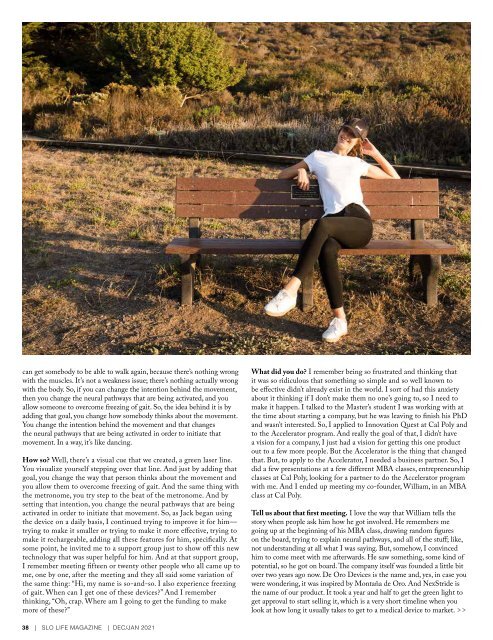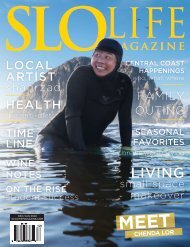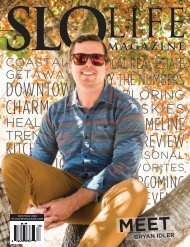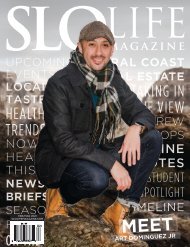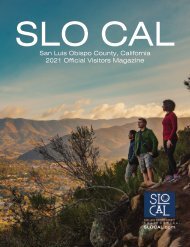You also want an ePaper? Increase the reach of your titles
YUMPU automatically turns print PDFs into web optimized ePapers that Google loves.
can get somebody to be able to walk again, because there’s nothing wrong<br />
with the muscles. It’s not a weakness issue; there’s nothing actually wrong<br />
with the body. So, if you can change the intention behind the movement,<br />
then you change the neural pathways that are being activated, and you<br />
allow someone to overcome freezing of gait. So, the idea behind it is by<br />
adding that goal, you change how somebody thinks about the movement.<br />
You change the intention behind the movement and that changes<br />
the neural pathways that are being activated in order to initiate that<br />
movement. In a way, it’s like dancing.<br />
How so? Well, there’s a visual cue that we created, a green laser line.<br />
You visualize yourself stepping over that line. And just by adding that<br />
goal, you change the way that person thinks about the movement and<br />
you allow them to overcome freezing of gait. And the same thing with<br />
the metronome, you try step to the beat of the metronome. And by<br />
setting that intention, you change the neural pathways that are being<br />
activated in order to initiate that movement. So, as Jack began using<br />
the device on a daily basis, I continued trying to improve it for him—<br />
trying to make it smaller or trying to make it more effective, trying to<br />
make it rechargeable, adding all these features for him, specifically. At<br />
some point, he invited me to a support group just to show off this new<br />
technology that was super helpful for him. And at that support group,<br />
I remember meeting fifteen or twenty other people who all came up to<br />
me, one by one, after the meeting and they all said some variation of<br />
the same thing: “Hi, my name is so-and-so. I also experience freezing<br />
of gait. When can I get one of these devices?” And I remember<br />
thinking, “Oh, crap. Where am I going to get the funding to make<br />
more of these?”<br />
What did you do? I remember being so frustrated and thinking that<br />
it was so ridiculous that something so simple and so well known to<br />
be effective didn’t already exist in the world. I sort of had this anxiety<br />
about it thinking if I don’t make them no one’s going to, so I need to<br />
make it happen. I talked to the Master’s student I was working with at<br />
the time about starting a company, but he was leaving to finish his PhD<br />
and wasn’t interested. So, I applied to Innovation Quest at Cal Poly and<br />
to the Accelerator program. And really the goal of that, I didn’t have<br />
a vision for a company, I just had a vision for getting this one product<br />
out to a few more people. But the Accelerator is the thing that changed<br />
that. But, to apply to the Accelerator, I needed a business partner. So, I<br />
did a few presentations at a few different MBA classes, entrepreneurship<br />
classes at Cal Poly, looking for a partner to do the Accelerator program<br />
with me. And I ended up meeting my co-founder, William, in an MBA<br />
class at Cal Poly.<br />
Tell us about that first meeting. I love the way that William tells the<br />
story when people ask him how he got involved. He remembers me<br />
going up at the beginning of his MBA class, drawing random figures<br />
on the board, trying to explain neural pathways, and all of the stuff; like,<br />
not understanding at all what I was saying. But, somehow, I convinced<br />
him to come meet with me afterwards. He saw something, some kind of<br />
potential, so he got on board. The company itself was founded a little bit<br />
over two years ago now. De Oro Devices is the name and, yes, in case you<br />
were wondering, it was inspired by Montaña de Oro. And NexStride is<br />
the name of our product. It took a year and half to get the green light to<br />
get approval to start selling it, which is a very short timeline when you<br />
look at how long it usually takes to get to a medical device to market.<br />
>><br />
38 | <strong>SLO</strong> <strong>LIFE</strong> MAGAZINE | DEC/JAN <strong>20</strong><strong>21</strong>


